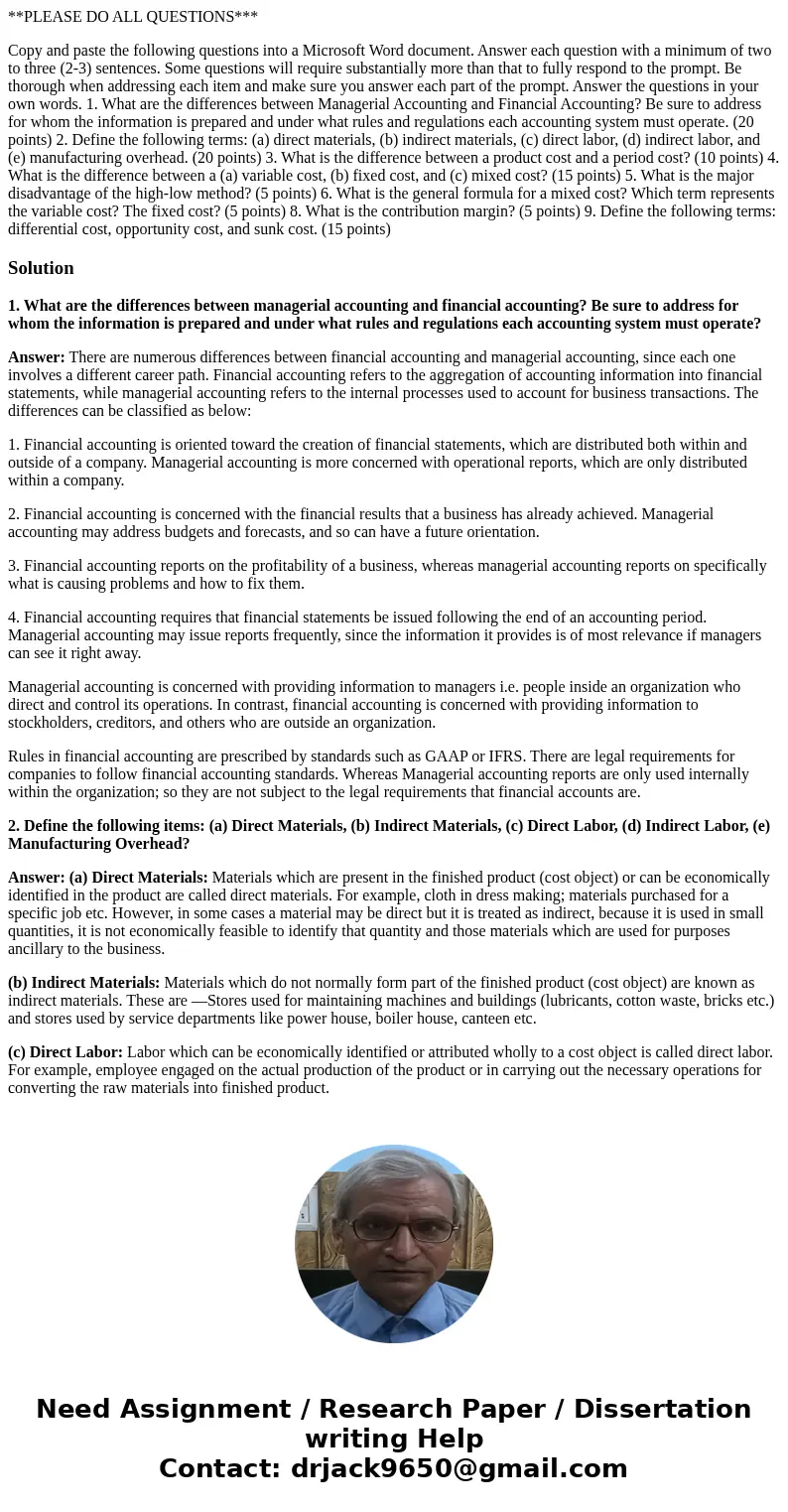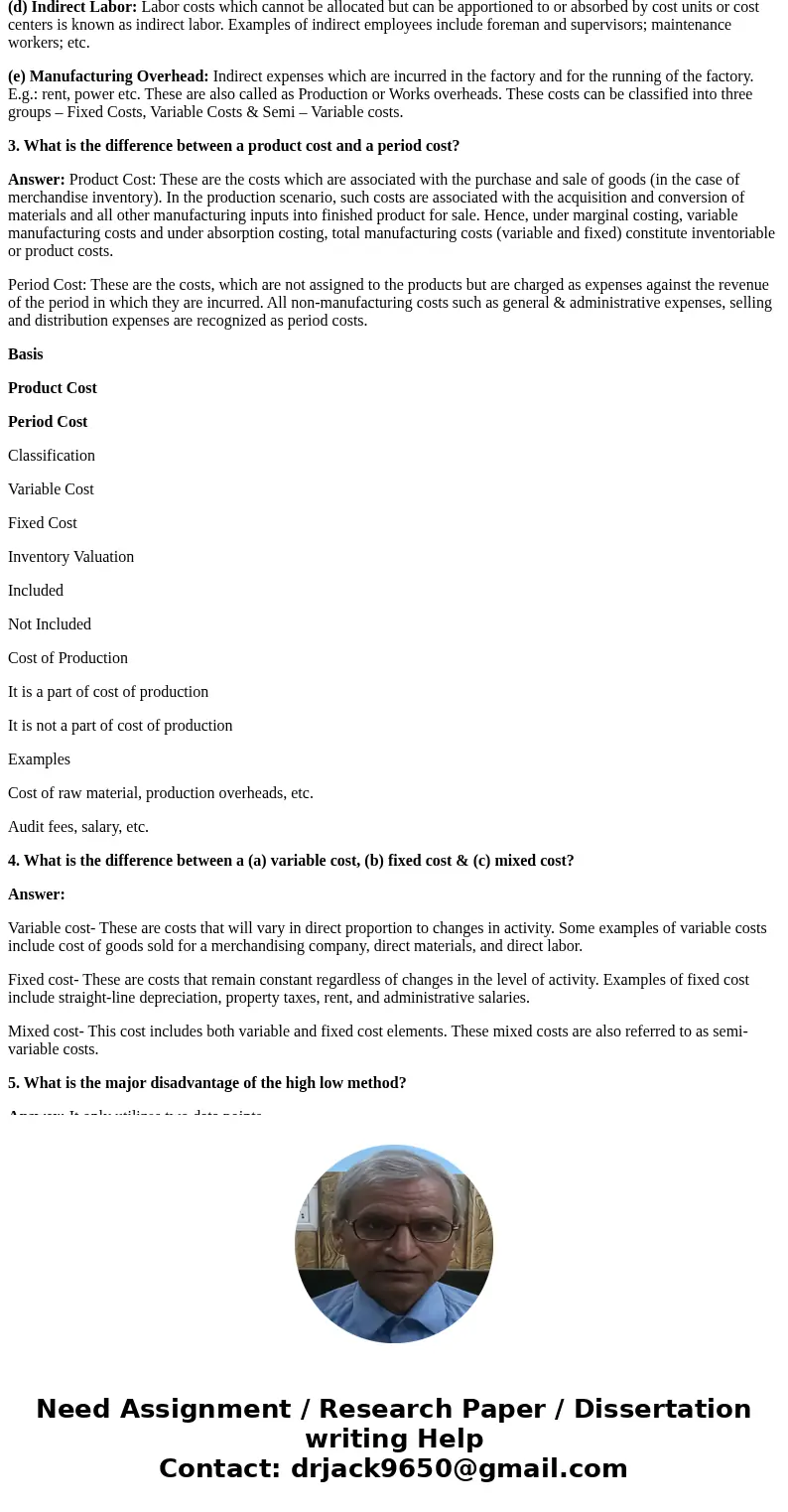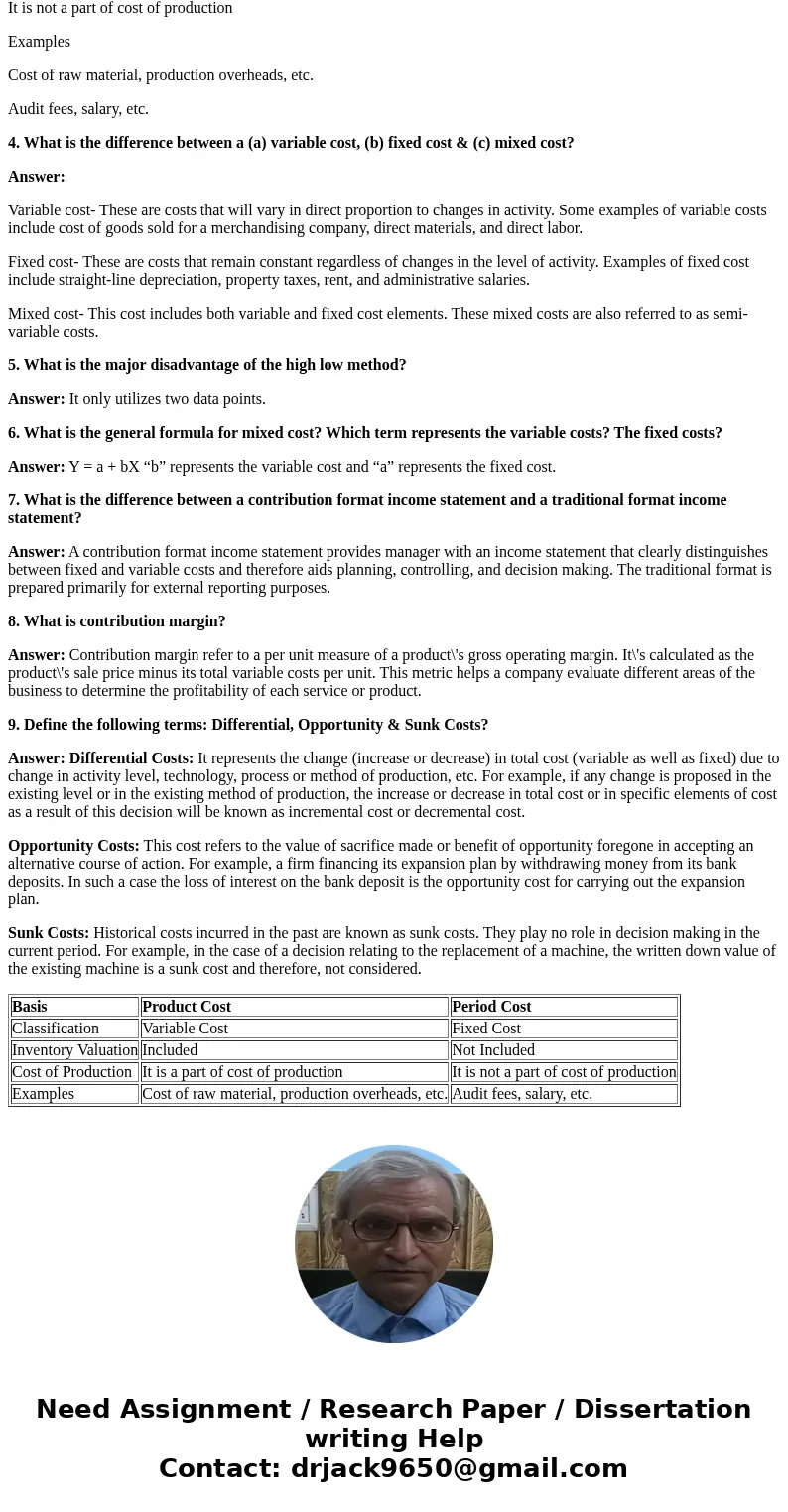PLEASE DO ALL QUESTIONS Copy and paste the following questio
**PLEASE DO ALL QUESTIONS***
Copy and paste the following questions into a Microsoft Word document. Answer each question with a minimum of two to three (2-3) sentences. Some questions will require substantially more than that to fully respond to the prompt. Be thorough when addressing each item and make sure you answer each part of the prompt. Answer the questions in your own words. 1. What are the differences between Managerial Accounting and Financial Accounting? Be sure to address for whom the information is prepared and under what rules and regulations each accounting system must operate. (20 points) 2. Define the following terms: (a) direct materials, (b) indirect materials, (c) direct labor, (d) indirect labor, and (e) manufacturing overhead. (20 points) 3. What is the difference between a product cost and a period cost? (10 points) 4. What is the difference between a (a) variable cost, (b) fixed cost, and (c) mixed cost? (15 points) 5. What is the major disadvantage of the high-low method? (5 points) 6. What is the general formula for a mixed cost? Which term represents the variable cost? The fixed cost? (5 points) 8. What is the contribution margin? (5 points) 9. Define the following terms: differential cost, opportunity cost, and sunk cost. (15 points)Solution
1. What are the differences between managerial accounting and financial accounting? Be sure to address for whom the information is prepared and under what rules and regulations each accounting system must operate?
Answer: There are numerous differences between financial accounting and managerial accounting, since each one involves a different career path. Financial accounting refers to the aggregation of accounting information into financial statements, while managerial accounting refers to the internal processes used to account for business transactions. The differences can be classified as below:
1. Financial accounting is oriented toward the creation of financial statements, which are distributed both within and outside of a company. Managerial accounting is more concerned with operational reports, which are only distributed within a company.
2. Financial accounting is concerned with the financial results that a business has already achieved. Managerial accounting may address budgets and forecasts, and so can have a future orientation.
3. Financial accounting reports on the profitability of a business, whereas managerial accounting reports on specifically what is causing problems and how to fix them.
4. Financial accounting requires that financial statements be issued following the end of an accounting period. Managerial accounting may issue reports frequently, since the information it provides is of most relevance if managers can see it right away.
Managerial accounting is concerned with providing information to managers i.e. people inside an organization who direct and control its operations. In contrast, financial accounting is concerned with providing information to stockholders, creditors, and others who are outside an organization.
Rules in financial accounting are prescribed by standards such as GAAP or IFRS. There are legal requirements for companies to follow financial accounting standards. Whereas Managerial accounting reports are only used internally within the organization; so they are not subject to the legal requirements that financial accounts are.
2. Define the following items: (a) Direct Materials, (b) Indirect Materials, (c) Direct Labor, (d) Indirect Labor, (e) Manufacturing Overhead?
Answer: (a) Direct Materials: Materials which are present in the finished product (cost object) or can be economically identified in the product are called direct materials. For example, cloth in dress making; materials purchased for a specific job etc. However, in some cases a material may be direct but it is treated as indirect, because it is used in small quantities, it is not economically feasible to identify that quantity and those materials which are used for purposes ancillary to the business.
(b) Indirect Materials: Materials which do not normally form part of the finished product (cost object) are known as indirect materials. These are —Stores used for maintaining machines and buildings (lubricants, cotton waste, bricks etc.) and stores used by service departments like power house, boiler house, canteen etc.
(c) Direct Labor: Labor which can be economically identified or attributed wholly to a cost object is called direct labor. For example, employee engaged on the actual production of the product or in carrying out the necessary operations for converting the raw materials into finished product.
(d) Indirect Labor: Labor costs which cannot be allocated but can be apportioned to or absorbed by cost units or cost centers is known as indirect labor. Examples of indirect employees include foreman and supervisors; maintenance workers; etc.
(e) Manufacturing Overhead: Indirect expenses which are incurred in the factory and for the running of the factory. E.g.: rent, power etc. These are also called as Production or Works overheads. These costs can be classified into three groups – Fixed Costs, Variable Costs & Semi – Variable costs.
3. What is the difference between a product cost and a period cost?
Answer: Product Cost: These are the costs which are associated with the purchase and sale of goods (in the case of merchandise inventory). In the production scenario, such costs are associated with the acquisition and conversion of materials and all other manufacturing inputs into finished product for sale. Hence, under marginal costing, variable manufacturing costs and under absorption costing, total manufacturing costs (variable and fixed) constitute inventoriable or product costs.
Period Cost: These are the costs, which are not assigned to the products but are charged as expenses against the revenue of the period in which they are incurred. All non-manufacturing costs such as general & administrative expenses, selling and distribution expenses are recognized as period costs.
Basis
Product Cost
Period Cost
Classification
Variable Cost
Fixed Cost
Inventory Valuation
Included
Not Included
Cost of Production
It is a part of cost of production
It is not a part of cost of production
Examples
Cost of raw material, production overheads, etc.
Audit fees, salary, etc.
4. What is the difference between a (a) variable cost, (b) fixed cost & (c) mixed cost?
Answer:
Variable cost- These are costs that will vary in direct proportion to changes in activity. Some examples of variable costs include cost of goods sold for a merchandising company, direct materials, and direct labor.
Fixed cost- These are costs that remain constant regardless of changes in the level of activity. Examples of fixed cost include straight-line depreciation, property taxes, rent, and administrative salaries.
Mixed cost- This cost includes both variable and fixed cost elements. These mixed costs are also referred to as semi-variable costs.
5. What is the major disadvantage of the high low method?
Answer: It only utilizes two data points.
6. What is the general formula for mixed cost? Which term represents the variable costs? The fixed costs?
Answer: Y = a + bX “b” represents the variable cost and “a” represents the fixed cost.
7. What is the difference between a contribution format income statement and a traditional format income statement?
Answer: A contribution format income statement provides manager with an income statement that clearly distinguishes between fixed and variable costs and therefore aids planning, controlling, and decision making. The traditional format is prepared primarily for external reporting purposes.
8. What is contribution margin?
Answer: Contribution margin refer to a per unit measure of a product\'s gross operating margin. It\'s calculated as the product\'s sale price minus its total variable costs per unit. This metric helps a company evaluate different areas of the business to determine the profitability of each service or product.
9. Define the following terms: Differential, Opportunity & Sunk Costs?
Answer: Differential Costs: It represents the change (increase or decrease) in total cost (variable as well as fixed) due to change in activity level, technology, process or method of production, etc. For example, if any change is proposed in the existing level or in the existing method of production, the increase or decrease in total cost or in specific elements of cost as a result of this decision will be known as incremental cost or decremental cost.
Opportunity Costs: This cost refers to the value of sacrifice made or benefit of opportunity foregone in accepting an alternative course of action. For example, a firm financing its expansion plan by withdrawing money from its bank deposits. In such a case the loss of interest on the bank deposit is the opportunity cost for carrying out the expansion plan.
Sunk Costs: Historical costs incurred in the past are known as sunk costs. They play no role in decision making in the current period. For example, in the case of a decision relating to the replacement of a machine, the written down value of the existing machine is a sunk cost and therefore, not considered.
| Basis | Product Cost | Period Cost |
| Classification | Variable Cost | Fixed Cost |
| Inventory Valuation | Included | Not Included |
| Cost of Production | It is a part of cost of production | It is not a part of cost of production |
| Examples | Cost of raw material, production overheads, etc. | Audit fees, salary, etc. |



 Homework Sourse
Homework Sourse